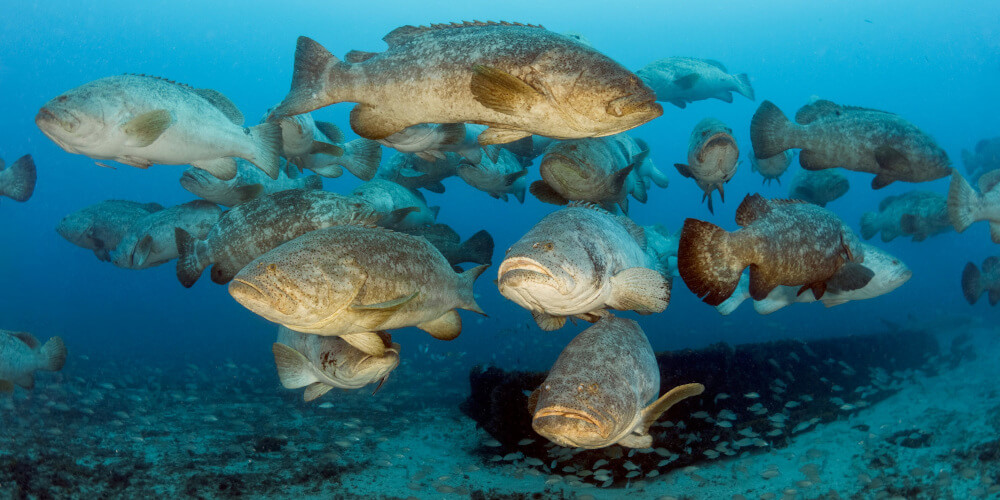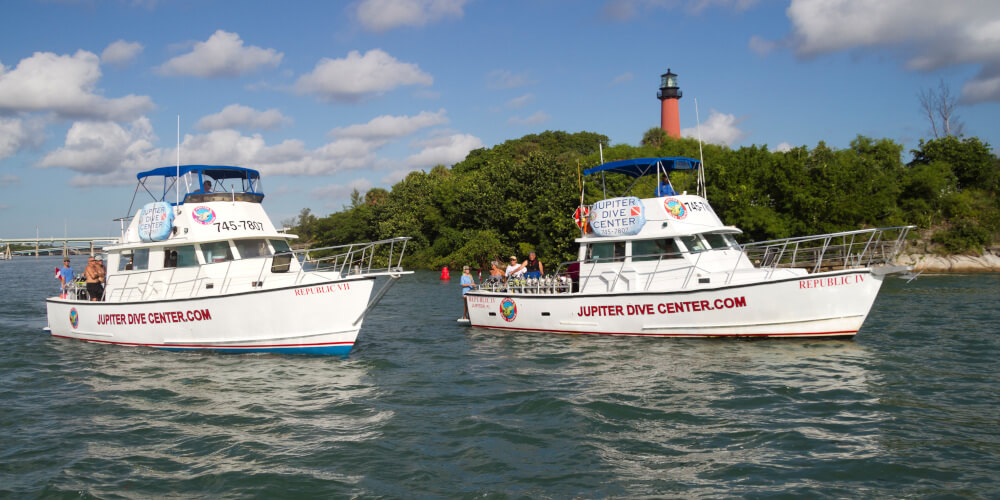JUPITER DIVE CENTER
Dealer Website: https://jupiterdivecenter.com/
![]() Jupiter, Florida
Jupiter, Florida

Where are the best dive spots near you?
- AREA 51
- Divers descend nearly 60 feet before hitting the top of Area 51. The bottom of the reef requires descending another 30 feet—making the vertical face of Area 51 the most extensive in the area. Known for an abundance of marine life, divers often see reef sharks at the beginning of the dive. Loggerhead sea turtles nap under the ledge, while hawksbills are often just beyond it. Large schools of Atlantic spadefish, as well as barracuda, bar jacks, amber jacks, and horse-eye jacks all call the reef home. Area 51’s name is a mystery—which may be the point. Or perhaps its name comes from the fact the site is 51 minutes from the dock. Either way, Area 51 teems with marine life and is a spectacular deep dive.
- Tunnels
- Tunnels is a spectacular site for two reasons: tunnels and big animals. Look for reef sharks immediately upon entering the water, but be forewarned, they disappear quickly. Once on the reef, slow down and savor this site—and bring a flashlight. Several goliath groupers usually hang out by the first of the three tunnels (and the only swim-through). The far side of the tunnel is an area known as the amphitheater—a popular area for small critters. Following the ledge north, divers almost always encounter schools of Atlantic spadefish. Move slowly and they will allow divers to pass through the school. Enormous southern rays frequent the sand to the west of the ledge. Can’t find them? Look for cobia. They are often in the area hoping to claim what the rays stir up. About 25 minutes into the dive, under a substantial ledge, divers will find several goliath groupers. With a moderate current, divers breathing nitrox will reach the Donut Hole section of the reef. Caribbean reef sharks are always there either napping in the hole or cruising to the east of it. Goliath groupers and nurse sharks like this area as well. The depth of this reef ranges between 65 and 75 feet.
- Wreck Trek
- The Jupiter Wreck Trek is a series of three wrecks that host big marine animals. The first, the Zion Train, is a small freighter listing to its port side in 90 feet of water. Inside the broken bow lives a resident goliath grouper. In late summer, dozens more aggregate on the wreck to spawn. East of the Zion Train, at 90 feet, is a pile of concrete beams. In January and February, this becomes a great area to view the visiting lemon sharks. Next up is the Miss Jenny, an upside-down barge, also in 90 feet of water. It’s home to goliath, gag, and black groupers. From there, set a 340-degree course (or look for intervals of rebar set every 30 feet that lead to the next wreck). The Esso Bonaire is the largest of the three sites and sits upright in 90 feet of water with her decks at 75 feet. An easy wreck to explore, her holds are open and the cabin area at the stern may be safely penetrated as long as the diver does not go into the lower areas. Again, do not be surprised to come face-to-face with a goliath grouper.
What would you see at the dive site(s)?
- Warm water. Pristine reefs. Exciting wrecks. The ocean off Jupiter, Florida offers divers a bit of everything—including plenty of opportunities to encounter large aquatic animals right off the coast! The dive seasons here are marked by an ever-changing list of visitors. January starts the year off with the arrival of lemon sharks. Sea turtles begin nesting in March and stay until October. Black tip reef sharks migrate through the area in May. In August and September, goliath groupers aggregate to spawn. Then there are the occasional whale sharks, hammerhead sharks, and manta rays that cruise through and keep our resident tropical fish company.

When is the best time to go?
- Year Round! January starts the year off with the arrival of lemon sharks. Sea turtles begin nesting in March and stay until October. Black tip reef sharks migrate through the area in May. In August and September, goliath groupers aggregate to spawn. Then there are the occasional whale sharks, hammerhead sharks, and manta rays that cruise through and keep our resident tropical fish company.
Recommended gear for the dive?
- Jupiter Dive Center suggests using Nitrox. Air divers are welcome. We have Scubapro full gear packages. We require surface marker buoy and computer.
How do you get to the dive site?
- We offer daily dive charters at 9 a.m. and adds an afternoon charter at 1:30 p.m. on weekends! Our two 40-foot dive boats, Republic IV and Republic VII are docked at our back door and ensure a comfortable trip to the dive sites.
What is the dive depth and visibility like?
- Explore the Jupiter area on a 2-tank dive. The first dive will be 60 to 90 feet on one of our beautiful reefs. The second dive will be 60 to 80 feet. For your dive adventure the captain will pick dive sites according to dive conditions on the day of the dive. 3- tank dives are available.
- Visibility averages 60 – 80 feet year-round.
Who takes the divers out?
- Our boat team consists of 3 seasoned captains, 3 first mates and all of our dive guides are active certified instructors, with SDI, PADI or TDI. Our retail staff has over 50 years of dive experience. We are lucky and honored to have such tenure with our team.
How do divers sign up or learn more?
- To Book a dive or learn more about our dive operation go to jupiterdivecenter.com or call us 561-745-7807. We are here to answer all your questions and ensure an excellent experience.
